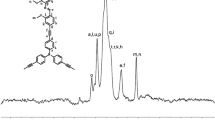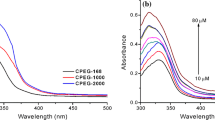Abstract
Inspired by the chromogenic reaction of itaconic anhydride and tertiary amine, fluorescent poly(amino ester) polyols are designed and synthesized by melt polycondensation of itaconic anhydride and triethanolamine. The obtained polymers contain no conventional conjugated fluorophores and still display bright fluorescence and good water solubility. The unconventional fluorescence is speculated to be due to the clusters of oxidized tertiary amines and carbonyl groups. Interestingly, the fluorescent polymers exhibit selective sensitivity to specific metal ions, which quench the fluorescence of the polymers. When various metal ions including Na+, Mg2+, Al3+, K+, Ca2+, Mn2+, Fe2+, Fe3+, Co2+, Ni2+, Cu2+, Zn2+, Ba2+ and Pb2+ are added to the aqueous polymer solution, only Fe3+ ions decrease dramatically the fluorescence intensity of the polymer solution. Meanwhile, the quenched fluorescence can be recovered by adding l-cysteine. Therefore, the fluorescent polymers can be applied as new sensing platform for label-free detection of Fe3+ ions and l-cysteine.












Similar content being viewed by others
References
You C, Miranda OR, Gider B, Ghosh PS, Kim I, Erdogan B, Krovi SA, Bunz UHF, Rotello VM (2007) Detection and identification of proteins using nanoparticle–fluorescent polymer ‘chemical nose’sensors. Nat Nanotechnol 2:318–323
Feng X, Liu L, Wang S, Zhu D (2010) Water-soluble fluorescent conjugated polymers and their interactions with biomacromolecules for sensitive biosensors. Chem Soc Rev 39:2411–2419
Pu K, Liu B (2011) Fluorescent conjugated polyelectrolytes for bioimaging. Adv Funct Mater 21:3408–3423
Feng G, Ding D, Liu B (2012) Fluorescence bioimaging with conjugated polyelectrolytes. Nanoscale 4:6150–6165
Chen M, Yin M (2014) Design and development of fluorescent nanostructures for bioimaging. Prog Polym Sci 39:365–395
Koo H, Lee H, Lee S, Min KH, Kim MS, Lee DS, Choi Y, Kwon IC, Kim K, Jeong SY (2010) In vivo tumor diagnosis and photodynamic therapy via tumoral pH-responsive polymeric micelles. Chem Commun 46:5668–5670
Zhu C, Liu L, Yang Q, Lv F, Wang S (2012) Water-soluble conjugated polymers for imaging, diagnosis, and therapy. Chem Rev 112:4687–4735
Gao GH, Lee DS (2013) Environmental pH-sensitive polymeric micelles for cancer diagnosis and targeted therapy. J Controll Release 169:180–184
Zhang Y, Yang J (2013) Design strategies for fluorescent biodegradable polymeric biomaterials. J Mater Chem B 1:132–148
Lee WI, Bae Y, Bard AJ (2004) Strong blue photoluminescence and ECL from OH-terminated PAMAM dendrimers in the absence of gold nanoparticles. J Am Chem Soc 126:8358–8359
Wang D, Imae T (2004) Fluorescence emission from dendrimers and its pH dependence. J Am Chem Soc 126:13204–13205
Yang W, Pan C (2009) Synthesis and fluorescent properties of biodegradable hyperbranched poly (amido amine)s. Macromol Rapid Commun 30:2096–2101
Jiang G, Wang Y, Sun X, Shen J (2010) Facile one-pot approach for preparing fluorescent and biodegradable hyperbranched poly (amidoamine)s. Polym Chem 1:618–620
Yang J, Zhang Y, Gautam S, Liu L, Dey J, Chen W, Mason RP, Serrano CA, Schug KA, Tang L (2009) Development of aliphatic biodegradable photoluminescent polymers. Proc Natl Acad Sci USA 106:10086–10091
Hu J, Guo J, Xie Z, Shan D, Gerhard E, Qian G, Yang J (2016) Fluorescence imaging enabled poly (lactide-co-glycolide). Acta Biomater 29:307–319
Wu D, Liu Y, He C, Goh SH (2005) Blue photoluminescence from hyperbranched poly (amino ester)s. Macromolecules 38:9906–9909
Shiau S, Juang T, Chou H, Liang M (2013) Synthesis and properties of new water-soluble aliphatic hyperbranched poly (amido acids) with high pH-dependent photoluminescence. Polymer 54:623–630
Restani RB, Morgado PI, Ribeiro MP, Correia IJ, Aguiar-Ricardo A, Bonifácio VDB (2012) Biocompatible polyurea dendrimers with pH-dependent fluorescence. Angew Chem Int Ed 51:5162–5165
Lin Y, Gao J, Liu H, Li Y (2009) Synthesis and characterization of hyperbranched poly (ether amide) s with thermoresponsive property and unexpected strong blue photoluminescence. Macromolecules 42:3237–3246
Lu H, Feng L, Li S, Zhang J, Lu H, Feng S (2015) Unexpected strong blue photoluminescence produced from the aggregation of unconventional chromophores in novel siloxane–poly (amidoamine) dendrimers. Macromolecules 48:476–482
Song G, Lin Y, Zhu Z, Zheng H, Qiao J, He C, Wang H (2015) Strong fluorescence of poly (N-vinylpyrrolidone) and its oxidized hydrolyzate. Macromol Rapid Commun 36:278–285
Niu S, Yan H, Chen Z, Yuan L, Liu T, Liu C (2016) Water-soluble blue fluorescence-emitting hyperbranched polysiloxanes simultaneously containing hydroxyl and primary amine groups. Macromol Rapid Commun 37:136–142
Jia D, Cao L, Wang D, Guo X, Liang H, Zhao F, Gu Y, Wang D (2014) Uncovering a broad class of fluorescent amine-containing compounds by heat treatment. Chem Commun 50:11488–11491
Chu C, Imae T (2009) Fluorescence investigations of oxygen-doped simple amine compared with fluorescent PAMAM dendrimer. Macromol Rapid Commun 30:89–93
Wang D, Imae T, Miki M (2007) Fluorescence emission from PAMAM and PPI dendrimers. J Colloid Interface Sci 306:222–227
Yan D, Gao C (2000) Hyperbranched polymers made from A2 and BB’2 type monomers. 1. Polyaddition of 1-(2-aminoethyl)piperazine to divinyl sulfone. Macromolecules 33:7693–7699
Chen H, Kong J (2016) Hyperbranched polymers from A2 + B3 strategy: recent advances in description and control of fine topology. Polym Chem 7:3643–3663
Zhao E, Lam JWY, Meng L, Hong Y, Deng H, Bai G, Huang X, Hao J, Tang BZ (2015) Poly[(maleic anhydride)-alt-(vinyl acetate)]: a pure oxygenic nonconjugated macromolecule with strong light emission and solvatochromic effect. Macromolecules 48:64–71
Du Y, Yan H, Huang W, Chai F, Niu S (2017) Unanticipated strong blue photoluminescence from fully biobased aliphatic hyperbranched polyesters. ACS Sustain Chem Eng 5:6139–6147
Dou X, Zhou Q, Chen X, Tan Y, He X, Lu P, Sui K, Tang BZ, Zhang Y, Yuan WZ (2018) Clustering-triggered emission and persistent room temperature phosphorescence of sodium alginate. Biomacromol 19:2014–2022
Gong YY, Tan YQ, Mei J, Zhang YR, Yuan WZ, Zhang YM, Sun JZ, Tang BZ (2013) Room temperature phosphorescence from natural products: crystallization matters. Sci Chin Chem 56:1178–1182
Chen X, Luo W, Ma H, Peng Q, Yuan WZ, Zhang Y (2018) Prevalent intrinsic emission from nonaromatic amino acids and poly(amino acids). Sci Chin Chem 61:351–359
Tang L, Ji R, Li X, Teng KS, Lau SP (2013) Energy-level structure of nitrogen-doped graphene quantum dots. J Mater Chem C 1:4908–4915
Thomas SW III, Joly GD, Swager TM (2007) Chemical sensors based on amplifying fluorescent conjugated polymers. Chem Rev 107:1339–1386
Aragay G, Pons J, Merkoçi A (2011) Chemical sensors based on amplifying fluorescent conjugated polymers. Chem Rev 111:3433–3458
Liu Z, He W, Guo Z (2013) Metal coordination in photoluminescent sensing. Chem Soc Rev 42:1568–1600
Ehlers AW, Dapprich S, Vyboishchikov SF, Frenking G (1996) Structure and bonding of the transition-metal carbonyl complexes M(CO)5L (M = Cr, Mo, W) and M(CO)3L (M = Ni, Pd, Pt; L = CO, SiO, CS, N2, NO+, CN−, NC−, HCCH, CCH2, CH2, CF2, H2)1. Organometallics 15:105–117
Li NC, Manning RA (1955) Some metal complexes of sulfur-containing amino acids. J Am Chem Soc 77:5225–5228
Shindo H, Brown TL (1965) Infrared spectra of complexes of l-cysteine and related compounds with zinc(II), cadmium(II), mercury(II), and lead(II). J Am Chem Soc 87:1904–1909
Zhou Y, Yoon J (2012) Recent progress in fluorescent and colorimetric chemosensors for detection of amino acids. Chem Soc Rev 41:52–67
Zhou L, Lin Y, Huang Z, Ren J, Qu X (2011) Carbon nanodots as fluorescence probes for rapid, sensitive, and label-free detection of Hg 2 + and biothiols in complex matrices. Chem Commun 48:1147–1149
Acknowledgments
The authors gratefully acknowledge the financial support from the National Natural Science Foundation of China (Grant No.51773120), the Natural Science Foundation of Guangdong (Grant Nos. 2014A030313559, 2016A030313050, 2017A030310045), the National Natural Science Foundation of Guangdong Province for Vertical Coordination Project (No. 201642), the Nanshan District Key Lab for Biopolymers and Safety Evaluation (No. KC2014ZDZJ0001A) the Science and Technology Project of Shenzhen City (Grant Nos. JCYJ20170412105034748, CYZZ20150827160341635, and ZDSYS201507141105130), and the Top Talent Launch Scientific Research Projects of Shenzhen (827-000133).
Author information
Authors and Affiliations
Corresponding authors
Electronic supplementary material
Below is the link to the electronic supplementary material.
Rights and permissions
About this article
Cite this article
Chen, H., Dai, W., Huang, J. et al. Construction of unconventional fluorescent poly(amino ester) polyols as sensing platform for label-free detection of Fe3+ ions and l-cysteine. J Mater Sci 53, 15717–15725 (2018). https://doi.org/10.1007/s10853-018-2716-3
Received:
Accepted:
Published:
Issue Date:
DOI: https://doi.org/10.1007/s10853-018-2716-3




